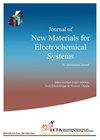Towards the Design and Analysis of Multiplexer/Demultiplexer Using Quantum Dot Cellular Automata for Nano Systems
IF 0.6
4区 材料科学
Q4 ELECTROCHEMISTRY
Journal of New Materials For Electrochemical Systems
Pub Date : 2022-03-31
DOI:10.14447/jnmes.v25i1.a09
引用次数: 5
Abstract
Quantum dot Cellular Automata (QCA) is a rapidly developing nanotechnology that offersultra-low energy loss, increased speed, and incredibly tiny area requirements. The two most important building blocks of QCA nano computing are the multiplexer and demultiplexer. The performance of new 2:1 multiplexer and 1:2 demultiplexer QCA layouts was investigated in this study. For a better performance study, two methodologies were used to measure energy loss, and alternative cost functions were explored. Total energy losses of 14.30 meV and 7.37 meV for the proposed multiplexer and demultiplexer, respectively, were detected using the software QDADesigner-E (QDE) in the Coherence vector simulation mode applying the Runge Kutta approximation technique. According to QCAPro, at the tunneling level 0.5EK and temperature 2K, the total energy loss of the multiplexer and the demultiplexer is 35.60 meV and 37.19 meV, respectively. Cost functions for both experimental items were also calculated in three different methods.基于量子点元胞自动机的纳米系统多路/解路设计与分析
量子点细胞自动机(QCA)是一种快速发展的纳米技术,它提供了低能量损失、更快的速度和令人难以置信的小面积要求。QCA纳米计算的两个最重要的组成部分是多路复用器和多路分解器。研究了新型2:1多路复用器和1:2多路分解器QCA布局的性能。为了更好地进行性能研究,使用了两种方法来测量能量损失,并探索了替代成本函数。在应用龙格-库塔近似技术的相干矢量模拟模式下,使用软件QDADesigner-E(QDE)检测到所提出的复用器和解复用器的总能量损失分别为14.30meV和7.37meV。根据QCAPro,在隧道能级0.5EK和温度2K下,多路复用器和多路分解器的总能量损失分别为35.60meV和37.19meV。两个实验项目的成本函数也用三种不同的方法计算。
本文章由计算机程序翻译,如有差异,请以英文原文为准。
求助全文
约1分钟内获得全文
求助全文
来源期刊

Journal of New Materials For Electrochemical Systems
ELECTROCHEMISTRY-MATERIALS SCIENCE, MULTIDISCIPLINARY
CiteScore
1.90
自引率
0.00%
发文量
33
审稿时长
>12 weeks
期刊介绍:
This international Journal is intended for the publication of original work, both analytical and experimental, and of reviews and commercial aspects related to the field of New Materials for Electrochemical Systems. The emphasis will be on research both of a fundamental and an applied nature in various aspects of the development of new materials in electrochemical systems.
 求助内容:
求助内容: 应助结果提醒方式:
应助结果提醒方式:


